Steph W. from SEOPressor


...help you check your website and tell you exactly how to rank higher?


95
score %
SEO Score

Found us from search engine?
We rank high, you can too.
SEOPressor helps you to optimize your on-page SEO for higher & improved search ranking.
By vivian on October 27, 2016
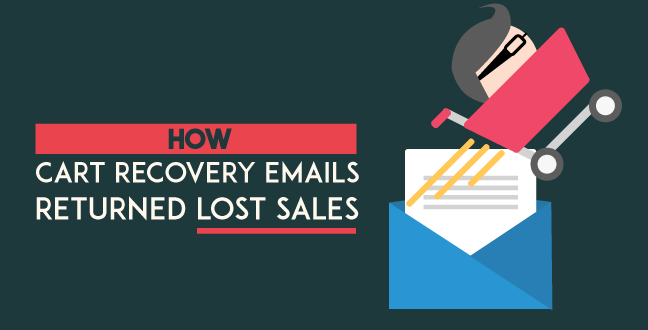
Earlier this year, we launched the new version of our flagship product, SEOPressor Connect.
The response has been great, but we noticed that quite a few potential customers left after showing purchase intent.
They signed up with their email, selected their desire package, but hopped out before paying.
This is known as shopping cart abandonment… but to make a long story short, we actually managed to recover most of those sales.
How, you ask? Cart recovery emails.
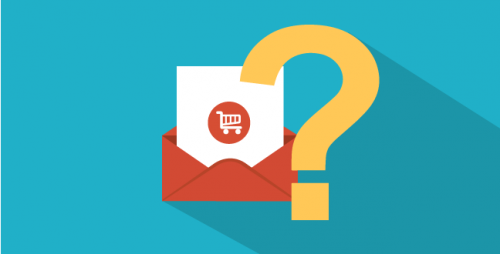
Cart recovery emails are follow up emails sent after customers started but didn’t complete their purchase.
Cart recovery emails are follow-up messages sent to customers after they abandon an online shopping cart. They’re intended to persuade customers to come back and complete their purchase.
According to a study by HubSpot, a full 75% of people who abandon their shopping card do so with the intent to return.
They’re not just wasting your time by dangling potential business in front of you. They really want to buy from you, so don’t give up on them.
What we did is using our email marketing platform (we use Aweber), and set it up so that people who abandon their carts are automatically grouped onto a list. From there, we sent a cart recovery email we crafted to rope them back in.
Before I tell you how to write the kind of recovery email that reverses shopping cart abandonment, you need to know the reason why visitors abandon their carts in the first place.
People will drop out of the process for many different reasons. To maximize the number of customers that come back to you, your company needs to learn how to figure out what happened.
Here are the most common reasons people drop out, based on our own observations:

It’s common for people to get distracted during purchasing process and forget about it afterwards.
Yes, believe it or not, this can happen! Many things can happen to people between the time they add a product to their cart and the time they go to pay.
For example, somebody at home could be distracted by a family member needing their help, and close out of the internet rather than completing the purchase. By the time they’re done, they may have entirely forgotten than they were planning to buy something.
This problem can be hard to spot, since customers usually don’t give much indication that they simply forgot about the cart. That said, if shopping cart abandonment goes on for more than an hour or so, there’s a pretty good chance it’s slipped their mind.
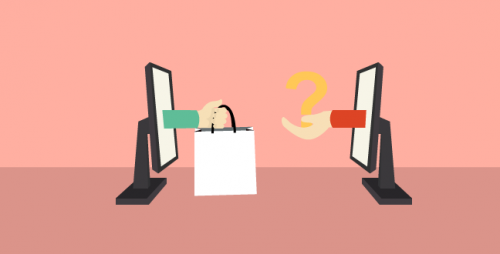
Online payment are fickle systems that can be interrupted by myriad of problems.
Popular payment methods like PayPal are usually reliable, but errors do happen sometimes. Errors can vary, of course.
Some people have network trouble when they’re trying to buy, so the order doesn’t go through. Other people might have forgotten how much money was available to them at the moment.
A few people – mostly those that aren’t tech-savvy – may not even know how to pay for something online. Don’t laugh, because this is a serious issue for groups like seniors who don’t have much experience with technology.

Customers might not be entirely confident of the capabilities or the need to have your products.
This is a more serious reason for shopping cart abandonment. If you haven’t truly convinced your customer that they need your product or if your product really works as claimed, they could hesitate to complete the transaction.
Fundamentally, this is less of a problem with your checkout process and more of an issue with the way you find your customers. A good warning sign of this is starting to check out, then looking at other pages on your site, especially those they’ve already been to.
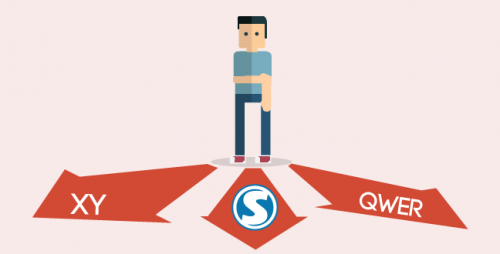
Savvy customers WILL compare your product with other alternatives.
Online shoppers are fairly savvy, and quite a few of them will compare your product to those of your competitors before they’re willing to buy it.
Most likely, they’ll be doing a side-by-side comparison in different tabs. Smart customers will be comparing things like price, features, and what kind of warranties and support you’re willing to offer them.
These customers are harder to get back than most of the others on this list, and account for a good portion of the 25% that leave with no intention of buying. After all, they might buy from someone else right away, in which case you’re basically out of luck.
However, some won’t be buying from anyone right away, so it’s still worth contacting them as part of your shopping cart abandonment recovery process.
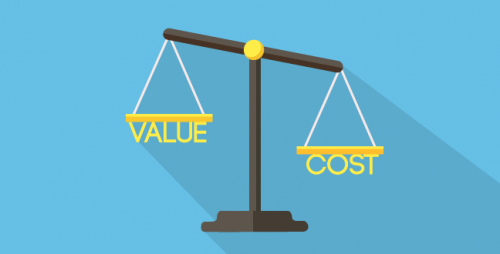
While a customer might like the idea of a product, they might not think the price they’re paying is worth the value they’re getting.
Sticker shock is a real issue in some industries. What this basically means is that customers saw your product, liked it even, but didn’t expect them to cost as much.
This is the case especially if your audience includes people with fairly limited budgets. They might be worried about their ability to get a return if the product just doesn’t work out, and they may feel that the price you’re asking is a little high for the value they expect to get.
Fundamentally, this is a problem with your messaging. If you aren’t conveying some kind of value to the customer, they’re far less willing to ultimately purchase your product.
Buying is often an emotional decision, rather than a rational one – they need to want the product before they actually check out.
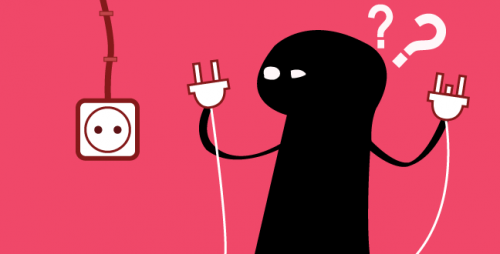
Having lots of functionalities often comes at the price of confusing new and learning users.
I was surprised the first time somebody mentioned this reason, but then I found out that it can actually be rather common. If you’re selling a product as robust as ours, customers might actually be worried about their ability to use it properly.
This is more and more of an issue as the cost of something goes up, and doubly true for anything that’s being sold as a discreet piece of software. Physical goods, after all, tend to be fairly self-explanatory… but software? If people don’t know where to begin, you’ll need to address that.

Humans are naturally resistant to change. Newer, better changes are often rejected in favor of the sense of familiarity.
This is another issue that surprised me, although in retrospect, I should have been expecting it. Your product might not be the first solution a customer has tried. Worse, they might be afraid of things like losing their sense of familiarity, saved settings or preferences.
Unfortunately, their desire to stick with what’s familiar can ultimately end up hurting them. It’s often hard to transfer things like saved settings between different pieces of software, so you’ll have to deal with this shopping cart abandonment a little more… creatively.
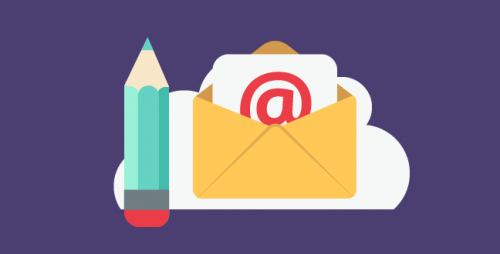
Now that we know the reason why people abandon their cart, it’s easier to write emails addressing them.
As you can see, shopping cart abandonment happens for a wide variety of reasons, and each of them has to be addressed in different ways.
Fortunately, it’s much easier to create a response for customers when you know why they’re dropping out.
If customers simply forgot about your product, the best thing to do is remind them that they left and prompt them to continue.
For example, you might sent an email with a title like “Hello [Name] – Your products are ready for checkout”. In this case, the content of the email should show them what’s in their cart and include a button to take them directly to checkout.
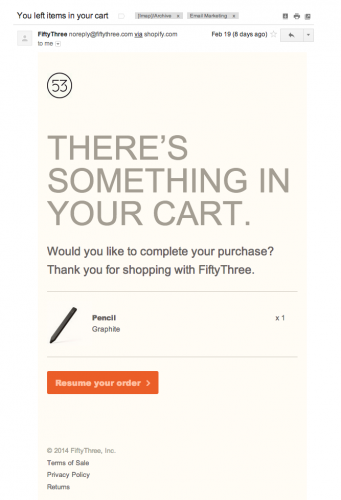
A friendly reminder that they haven’t completed their purchase along with shortcuts to complete them will get back forgetful customers
The goal here is to make it as easy as possible for them to complete the transaction. If possible, allow them to complete their purchase without needing to sign in again.
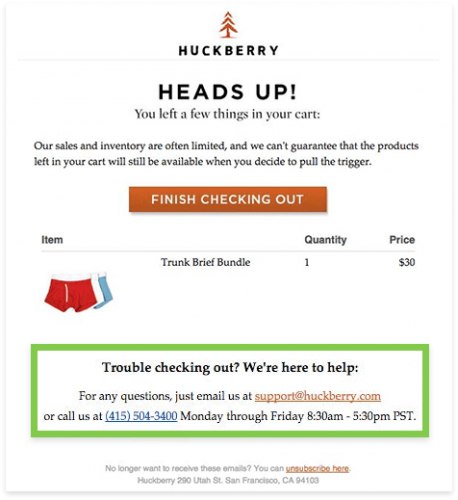
Offering support for technical difficulties in completing online payments will remove yet another type of cart abandonment
If you know that a customer had a payment problem – and your payment system should alert you whenever this happens – it’s time to walk them through the process.
Now, there are a few different ways to do this.
First, your followup email should have a step-by-step guide to making payments. It can include FAQs or tutorials, ideally showing the payment process through pictures and highlights.
Second, try to connect them with some sort of live support. Payment processors generally offer this sort of help, and it’s absolutely worth taking advantage of that. Just think of it as one of the benefits you’re paying them for.
Remember, many people who have payment issues are the type who struggle with technology – so keep it as beginner-friendly as possible!
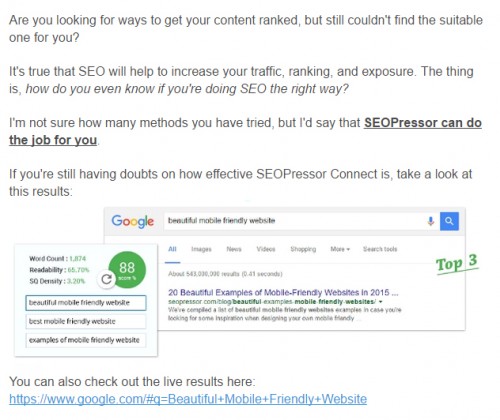
By demonstrating the results gained by using our products, we ensure customers of its effectiveness.
If people abandoned their cart because they weren’t sure they needed your product, you can usually entice them back by showcasing your product’s advantages.
For example, you can talk about the groundbreaking technology that powers your system, the thousands of satisfied customers you have, and what visitors who don’t use your product are missing out on.
Another effective method is by addressing their pain points. This is done by addressing the specific problems the customer face and how your product is designed to solve then.
Customer are more likely to yield if they know that you closely understand their struggle.
When to send this followup: This follows the same timing as #1. In fact, you may want to bundle these messages together into the same email. Instead of simply mentioning that they haven’t checked out, you could talk about how they haven’t finished getting your product, with a particular emphasis on whatever problem you’re trying to help solve.

Adding a comparison table saves the trouble of having to manually compare your product with the competition
If you think customers are leaving because they’re comparing you to others, you can do a side-by-side comparison with your top competitors. Your main goal here is to showcase your Unique Value Proposition – what sets your product apart from the competition.
Ultimately, this strategy focuses on the customer’s fear of missing out. They want to get the best product for their money, and if they’re not convinced that you’re better than their other options, of course they aren’t going to buy from you.
It helps if you use color psychology in these messages.
On a side note, we discovered an interesting discovery while doing our side-by-side comparison.
While conventional wisdom said you shouldn’t downplay your competitors, we tried something different. In addition to the standard “tick and cross” comparison table, we split tested another version replacing the X’s with a more tongue-in-cheek lines to illustrate what our competitors are lacking.
To our surprise, the lines converts better than a simple X mark. My guess is that they evoke emotions, illustrating benefits of adding a dash of honest and controversial marketing.
Sticker shock can be solved in a few different ways.
First, you can illustrate the ROI that the users can expect to get out of your products. You’ll want to detail how long it will be before they break even and, if possible, how they can ultimately profit from it.

By illustrating the returns customers gain from your products, it’s easier for them to justify the spending.
Second, you can avoid shopping cart abandonment by adding value to the purchase to tip the price scale in the customer’s favor.
These can be done by bundling a number of extras with the purchase like ebooks or free courses. These minor additions can massively enhance the sense of value that customers are receiving. Additionally, customers feel valued that you are willing go the extra mile to provide them with an exclusive deal.
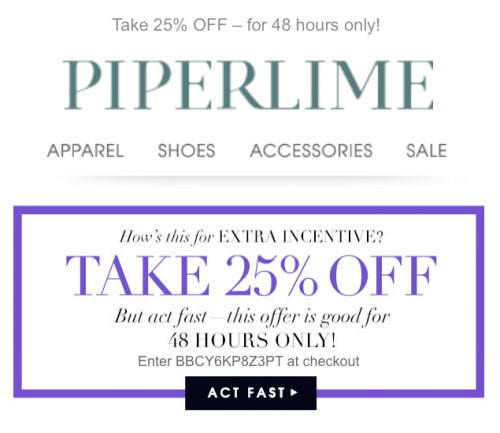
Giving discounts or freebies can help customers feel like they are getting more out of their purchase.
Fundamentally, people who think they’re getting a good deal are more likely to buy.
It really is that simple. In many cases, the price of a product is almost irrelevant – what really matters is whether or not customers think they’ll benefit from it.
Some demographics may experience sticker shock more often than others. If so, you can use your analytics to figure out who these customers are likely to be and send them a different followup message than everyone else gets.
Deals come in two forms. First, if you’re doing an immediate followup, you can say something like “We noticed that you were interested in this, and we’re so sure you’ll like it that we’re adding these bonuses to your purchase”. Try to add a sense of urgency, such as by saying the deal is only valid for 24 hours. Make sure to wait at least one hour before sending it.
Second, you can wait until the next time your product is on sale, and send a message letting them know that a product they expressed interest in is now more affordable. The longer you wait, the harder it is to reverse shopping cart abandonment, but it’s so easy to automate this process that it’s worth doing.
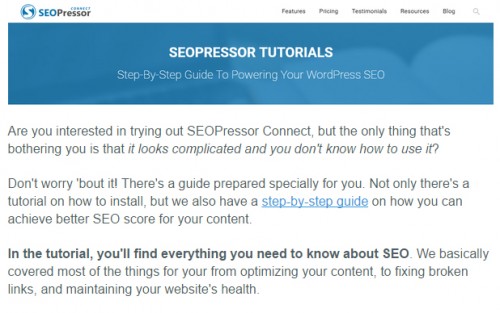
Showing them the way to your tutorials page and supporting their learning will make customers more eager to use your products.
This is a nice, easy one. If people often have trouble figuring out how to use your product, you can direct them to tutorial pages and emphasize that your staff is ready to answer any question.
The thing is, no matter how nicely done your tutorial page is, there will always be customers who can’t find their way there.
So the solution is simple – point the way. Other times, customers can’t be bothered to go through every page of the tutorial just to solve certain specific issue. In this case, assure them that your support team will be there to assist them at all times.
When to send this followup: The same schedule as #1. There’s nothing particularly notable about the timing for this followup, so it’s best to follow the standard schedule.
If you know that many of your customers used a different product before buying yours, you can reduce shopping cart abandonment by providing tutorials that align the similarities in the product and make the change as smooth as possible.
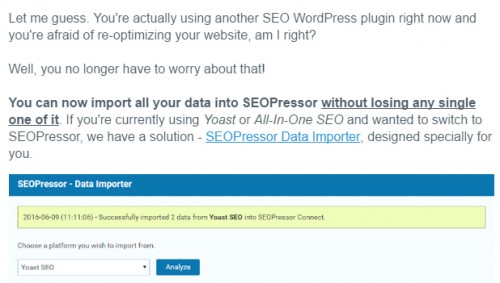
We sent emails guiding customers’ transitioning process and provide tools to aid them.
We actually took things a step further for SEOPressor by creating a data importer that works with both Yoast and All-in-One SEO Pack. We haven’t closed off access to other plugins, either – if there’s enough demand for help, we’ll meet that demand.
Really, that’s what it comes down to. This type of shopping cart abandonment occurs because people want more help getting set up, and if you can make it easier for them, they’re more likely to buy.
Don’t forget to emphasize that your customers will have access to tech support and can quickly get the answers to any problems they have.
All right, we’ve discussed the solutions for shopping cart abandonment in great detail right now – so let’s bring all of this together and look at the components of a good followup message. It should include:
We’re not just talking the talk on doing this – we actually reversed our shopping cart abandonment by putting these principles into practice. By the time we were done, more than half of our lost sales were recovered.
That’s a lot of extra sales for something that was only a few hours of work, and it’s continued to improve our checkout completion rate ever since.
In all seriousness, you should be sending cart abandonment emails to anyone who ditches without completing their purchase. Try it yourself and let us know how it went, because we’d love to hear the story of your success.
Updated: 19 November 2025


Save thousands of dollars (it’s 100x cheaper)

Zero risk of Google penalty (it’s Google-approved)

Boost your rankings (proven by case studies)
Rank High With This Link Strategy
Precise, Simplified, Fast Internal Linking.
